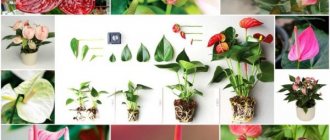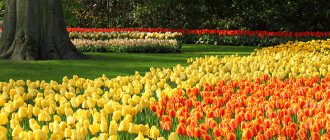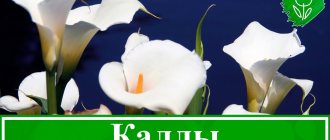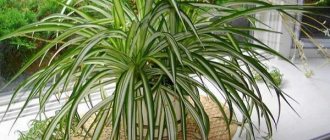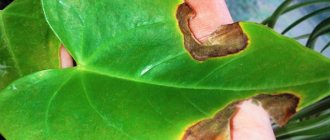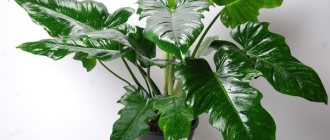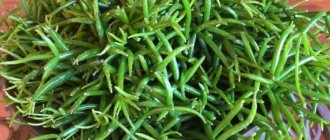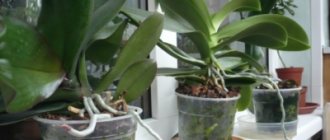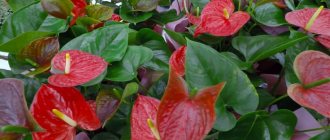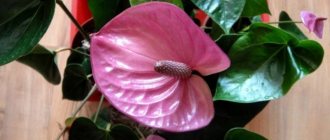Anthurium Scherzer: varieties and types with photos, home care
Anthurium from the Araceae family is the most numerous genus, numbering more than 500 species of evergreen herbaceous and liana-like plants. Thanks to its unpretentiousness in care and undemanding conditions, it is the Scherzer anthurium that has become widespread in indoor floriculture.
Botanical characteristics of the species
Anthurium Scherzer, native to the tropical climates of Central and South America, is a perennial, relatively low-growing plant with dark green leaf blades and a curved orange spadix wrapped in a heart-shaped red-orange spathe.
Unlike other species, for example, Andre's anthurium, this species has miniature dimensions - up to 30 cm in height, which is often a plus in home floriculture.
Another significant difference is that the Andre anthurium has a straight inflorescence, while the Scherzer anthurium has a twisted inflorescence.
The best varieties
Thanks to the continuous work of breeders, many miniature varieties with bracts of various colors were developed. Among the most popular representatives of the species, a wide range of which is presented in flower supermarkets, stand out:
- Anthurium Scherzer "Lacetti" is a variety used not only in indoor floriculture, but also for cutting when making bouquets. It is distinguished by a pink blanket framing a spiral-shaped inflorescence-cob, and leathery leaf plates of a contrasting dark green color with pointed edges.
- Anthurium Scherzer "Graffiti" - a distinctive feature of the plant is a wide blanket of white tone with scarlet asymmetrical splashes and a dense structure.
- Anthurium Scherzer "Hawaii" - a tropical representative, has become widely known among flower growers thanks to the two- or three-color coloring of the bracts.
- Anthurium Scherzer "Alexia Blue" - the sky-blue blankets highlight the variety and make it a favorite among gardeners.
- Anthurium Scherzer "Chocolate Love" is a variety with high decorative qualities, expressed by the contrasting combination of thick glossy green foliage with chocolate blankets.
- Anthurium Scherzer "Rubens" - inflorescences consisting of small flowers, have a spiral shape and are wrapped in a two-tone blanket, the upper part of which is painted pink and the base is green.
Home care for Scherzer's anthurium
Caring for Scherzer anthurium at home is quite simple, without much effort. The main thing is not to forget about the tropical origin of the plant and create conditions for it that are close to natural.
Lighting and location
Anthurium feels comfortable on windowsills in eastern and western directions with a sufficient amount of soft light, which will ensure the brightness of the flower and prevent burns on the leaf blades from the active rays of the open sun coming from southern windows.
Temperature
During the active growing season, anthurium grows excellently at room temperatures in the range of 20-25°C.
In summer, if possible, you can move the pot to fresh air - to a place protected from winds, precipitation and open sun.
With the arrival of winter, the mercury drops to 15°C.
The critical minimum is 10°C.
Air humidity
A moisture-loving representative of the tropics and subtropics needs an increased level of humidity, which can be provided in several ways:
- installation of a stationary air humidifier in the anthurium room;
- placing the container on a tray with moistened pebbles;
- spraying with soft, warm water around the plant.
Watering
The exotic flower is watered abundantly. However, before a new portion of water, the top layer of the soil mixture must have time to dry.
The remaining liquid from the pan must be poured out. With the arrival of winter, when vegetation processes slow down, Scherzer's anthurium is moistened much less frequently.
Priming
The root system of anthurium needs free access to air and water, which can be easily provided using a light substrate with a loose structure.
The soil mixture can be purchased ready-made or made with your own hands from leaf soil, peat, sand and vermiculite in a ratio of 2:2:1:1.
Transfer
Young specimens of Scherzer's anthurium require replanting every spring, but as they grow older, the interval between procedures increases to 3-4 years , depending on the filling of the substrate with the roots of the plant. A tropical flower is transplanted according to the following scheme:
- A tall and rather narrow pot is selected, which will stimulate rapid flowering.
- The bottom of the container is lined with a drainage layer of gravel or expanded clay.
- The top of the drainage is sprinkled with a soil mixture with a loose structure, onto which the flower is placed by transshipment.
- The remaining space is filled with fresh soil mixture, which is slightly compacted and moistened.
Feeding and fertilizers
During the period of active growth, anthurium spends a lot of strength and energy, which must be replenished with additional nutrition.
At this time, feeding is carried out twice a month using liquid mineral fertilizers with a high content of phosphorus and potassium. In winter there is no need to enrich the soil.
Diseases, pests and control methods
Among the diseases that can affect the moisture-loving Scherzer anthurium are various rots caused by an excess of soil and air moisture. It is possible to cure the affected specimen in the early stages when:
- The affected parts of the shoots or roots are removed.
- The plant is planted in a fresh substrate, after which it is treated with a fungicide solution.
An inhabitant of the tropics can be attacked by such harmful insects as aphids, scale insects, thrips, spider mites, and whiteflies. As a protective measure, the potted crop is sprayed with an insecticidal preparation according to the manufacturer's instructions.
Reproduction
At home, anthurium propagates by vegetative methods, but the seed propagation method is also possible.
Dividing the bush
The simplest method is:
- When transplanting, the extracted overgrown bush is divided into parts, each of which must have formed roots.
- The cut areas are treated with crushed charcoal or activated carbon.
- The divisions are planted in individual pots with a drainage layer and nutrient substrate.
Side shoots
Reception is also known as propagation by children and is carried out during transplantation:
- Side shoots are separated with a sterile sharp object and placed in a moist substrate of sand and peat for rooting.
- After the formation of a full-fledged root system, new plants are planted in permanent pots.
Cuttings
Many varieties can be propagated using cuttings when:
- A part of the shoot with several aerial roots and 2-3 internodes is cut off at an angle.
- The cut is treated with a growth stimulator to stimulate root formation.
- The cutting is buried 3-5 cm in damp vermiculite and covered with a bottle to create greenhouse conditions.
- For successful rooting, the cuttings are provided with high humidity , a temperature in the range of 23-26°C and long daylight hours with soft lighting.
- When a new plant develops roots 4-5 cm long, the Scherzer anthurium can be planted in an individual container with a substrate for an adult plant.
Leaf propagation
Although some members of the Araceae family can grow from leaves, this does not apply to anthuriums. Often the wording hides cuttings, which means cutting a leaf plate with part of a shoot. In this case, rooting is carried out according to the scheme described above.
Propagation by seeds
The seed method is labor-intensive and unproductive in comparison with vegetative methods. As a rule, breeders resort to it when developing new varieties and hybrids.
If the florist decides on a similar experience, then:
- During the flowering period, artificial pollination of the plant is carried out.
- After 8-12 months, the ripened seeds are collected.
- The seed material is cleaned and disinfected in a manganese solution.
- The container is filled with a well-structured substrate, over the surface of which the seeds are distributed without embedding.
- The crops are covered with film and moved to a warm, bright place , where they are systematically moistened and ventilated.
- After emergence of shoots, the film is removed.
- The first picking is carried out after the formation of a true leaf.
- As they grow at a slow pace, the seedlings dive several more times.
This video contains details of caring for a beautiful plant:
Thus, subject to simple care rules and ensuring optimal maintenance conditions, a bright representative of the tropical flora will become the highlight of the apartment interior for many years, delighting household members with the bright colors of decorative shoots and flowers.
Source: https://ProZvety.ru/katalog-rastenij/krasivotsvetushhie/anturium-shercera-sorta-s-foto-uhod-v-domashnih-usloviyah
Reproduction
Most often, indoor plants are propagated vegetatively - it’s simple and convenient. But you can grow a new bush using seeds.
Dividing the bush
The simplest and most commonly practiced propagation method is dividing an adult bush during transplantation .
The mother plant is divided into two or more parts. The main condition for separation will be the developed root of the shoot. Each division must be planted in a separate pot. The separation areas must be treated with crushed activated carbon.
Cuttings
A popular method of propagating anthurium. For successful implementation, a healthy shoot is cut off from the mother plant, always at a slight angle.
The cut is treated with a growth stimulator (you can dip the cut of the shoot in honey) and placed in a mini-greenhouse with vermiculite. The sprout needs high humidity and a temperature of about +26 °C.
When the sprout forms roots about 4 cm long, it can be transplanted into an individual pot.
Side shoots
This method of propagation is used when transplanting the mother plant into a new container. shoots are separated with a sterile blade and placed in a small greenhouse .
Leaf propagation
Anthurium does not root well with leaf blades.
Often, propagation by leaf means cuttings; the cut is simply made closer to the leaf blade , and the cutting comes out short. Further care is the same as for cuttings.
Propagation by seeds
This method is most often used by breeders to develop a new variety. It is labor-intensive and not always effective; it requires a certain skill and patience .
First of all, flowers are artificially pollinated. After about 9 months, you can collect the seeds and process them, preparing them for sowing:
- The seeds are placed on the prepared substrate; there is no need to bury them. The container is covered with film.
- The greenhouse with crops is placed in a warm, well-lit place.
- The substrate is regularly watered with warm water at room temperature.
- When shoots appear, the film can be removed. As the seedlings develop, the sprouts peak.
Anthurium Scherzer is a very impressive plant that will not burden the owner with complex care. It is undemanding, beautiful and will delight you with regular flowering for a long time.
Scherzer (Scherzerianum), care and maintenance
Family: Araceae Genus: Anthurium Species: Scherzerianum Latin name: Anthurium Scherzerianum Common name: Flamingo Flower
Climate: Tropical
This type of anthurium comes from Costa Rica, where it grows in tropical forests. Currently, there are more than 40 varieties of this plant.
The "flower" is not actually a flower in anthuriums. It is essentially a leaf that differs in color. A true flower is a spadix containing microscopic inflorescences.
This is a low plant with oblong, pointed leaves up to 20 cm long, on greatly shortened stems. A spectacular wax flower up to 5 cm in size with its own mysteries. The colors are varied: white, pink, red, speckled.
A distinctive feature is that its cob is longer and more twisted, unlike Andre’s cob. The amazing thing about these plants is that each flower has a male and a female part.
However, these parts are active at different times, so pollination is only possible artificially.
The spathe is oval, bent down, so that the inflorescence on a long peduncle resembles a flamingo.
Therefore, in Europe this species was called “flamingo flower”. This species is more or less adapted to indoor conditions.
Scherzera is considered not a very whimsical plant. The height of this type of crop is characterized by the low position of the stems. The leaves are dark green and lanceolate.
Its flowers have a curved shape of a rich orange, reddish hue. The cobs last for quite a long time. The bedspread is heart-shaped, coral-orange in color.
It has been noticed that recently varieties with different scales have appeared, so-called hybrids, which are pleasing to the eyes of others.
If you see a slightly unusual Scherzer anthurium, then rest assured that different shades of this flower are quite possible.
Some bedspreads differ from each other; there are also large white dots on them. “Lady Jane” and “Renata” are distinguished by their rather high height of 60 cm. Their spathes are oval, the inflorescences are small, they bloom early to five to seven centimeters.
Care, lighting
Scherzera does not have special care features, like ordinary flower crops; this flower needs good observation and proper cultivation (more about lighting).
In the summer heat, it is recommended to expose the flower pot to the air, but not on hot days; beware of drafts and direct rays.
Like all plants, Scherzer's anthurium loves diffused light. But you shouldn’t put it in the shade either, it may lose its green color.
Temperature and humidity
Like Andre, the Scherzer flower requires proper care; the temperature for proper development should be equal to or above 15 degrees; during the active growing season, try to provide the plant with 20-25 C of heat.
Humidity is an important factor for the proper growth of Anthurium Scherzer; all tropical crops love moist air. When humidity levels are low, spray the plant more often with water that matches the air temperature.
Feeding, watering
Regarding the soil, it must also be moist; the substrate should not be dry. In hot summer weather, it is important not to skip watering. Spring and summer are the ideal time to feed the crop with liquid and complex fertilizer. Dilute 10 g of fertilizer in a bucket of warm water. During the winter season, it is also worth fertilizing the tree of happiness at least once a week.
Transplantation and propagation
The topic of transplanting and the type of anthurium - Scherzer was not ignored.
Replant the plant annually in a new pot according to the size of the roots.
The diameter of the container for transplanting large varieties should be at least 20 cm, and miniature varieties can fit in a pot with a circumference of 7-8 cm. Scherzera grows ideally in soil with peat, pH level 5-6.
After propagation by seeds, the plant will begin to bloom after three years. The originality of the characteristics of the Scherzer culture may not be preserved due to their cultivation from seeds. It is advisable to propagate the crop by dividing the bush; March and April are good for this.
For this method of propagation, it is worth taking an adult plant, consisting of independent shoots and several bushes.
Plant the separated part of the flower in peat soil. After the procedure, be sure to water the crop.
Diseases
Often, owners of beautiful anthurium flower crops complain about yellowing of the foliage; this can happen due to excessive lighting, cold weather, or excess moisture in the soil.
Heavy soil with poor or no drainage is also a source of root rot. Anthurium Scherzer can also be at risk of anthracnose and septoria. These are spots that appear on leaves and bedspreads due to excessive moisture in the soil. Anthurium is treated with fungicides. A dangerous disease for indoor plants is fusarium, which cannot be treated.
Always monitor the humidity level in the room, watering and irrigation of the crop.
Please rate the material:
Source: https://anturiumi.ru/sorta/scherzerianum.html
Anthurium Scherzer: care at home, 14 photos
Anthurium belongs to the large Araceae family and has more than 600 plant species, including evergreen herbaceous bushes and vines.
Not all types of flowers are suitable for indoor floriculture, but due to its attractive appearance and unpretentiousness to conditions, anthurium has firmly entered the galaxy of popular indoor plants .
Botanical description
Anthurium Scherzer, or Scherzerianum, has chosen the tropical climate of Costa Rica. More than 40 varieties of this flower are known. It is a low-growing, in comparison with other varieties, evergreen bush (about 30 cm in height) with lanceolate dark green leaves.
Particular attention is drawn to the anthurium inflorescence, which has a curved or spiral shape and is bright orange in color. It is set off by the bright red cover of the petal.
It is interesting that , which differs in color from other leaves, is usually mistaken for an anthurium flower In fact, the inflorescence of the plant is a spadix.
Graffiti
The petal cover of this flower is of moderate thickness, oval or slightly elongated, whitish in color.
There are a large number of bright red small dots along the bedspread, both on the outside and on the inside, which is how the plant got its name.
Hawaii
It has a truly tropical coloring: on its cover there can be 2-3 shades of color in combination with specks, which gives the plant an unusual variegation.
Lacetti
This variety of flower is cultivated not only for growing in pots, but also for forming cut compositions, since it does not fade for a long time. His bedspread is a beautiful bright pink color.
Chocolate love
A beautiful flower with spectacular contrasting coloring of the leaf blades and bedspread. The leaves have a glossy green color, and the cover is a shade of chocolate.
Alexia Blue
An unusual bright flower that is rarely found in our country. Its distinctive feature is a petal blanket of bright sky blue color.
Rubens
A very interesting variety of Scherzer anthurium is characterized by uneven coloring of the petal cover. At the base of the plate it is dark green, and towards the tip it changes to a pale pink color.
Light
Anthurium is shade-loving; it feels great on eastern and northwestern window sills. If you place a flower pot in a sunny room, it is better to choose a floor stand away from direct sunlight .
Ultraviolet radiation, especially in summer, can cause burns, causing the leaves to curl and turn yellow. Extensive burns will lead to weakening of the plant and even its death .
Planting and transplanting
Young plants up to 3 years old are replanted every year with the onset of spring. Adult plants do not require such frequent replanting; the procedure can be carried out once every 4 years , as the pot becomes small.
Recommendations for transplantation:
- Choose a container that is larger, but narrow enough to encourage the rapid release of flower stalks. If the flowerpot is wide, the anthurium will not bloom until the root system fills the provided volume.
- Be sure to add a drainage layer to the bottom - the roots of the plant do not tolerate direct contact with stagnant water.
- The drainage layer is covered with a small layer of soil, and the flower is transplanted into a new pot using the transshipment method.
- The free space is filled with loose soil and lightly compacted.
Fertilizers
When an anthurium blooms, it spends a lot of energy on forming and releasing a peduncle. During this period, it is important to support the plant by providing it with additional nutrition using liquid potassium-phosphorus complexes.
Feeding is allowed up to 2 times a month , but in winter there is no need for fertilizer, so it is better to abandon them.
Diseases and pests
The most common diseases of tropical plants are various types of rot; Scherzer's anthurium is no exception. Excessive watering and stagnant moisture lead to damage to the root system.
The first sign of disease development is yellowed leaves. It will be possible to save the flower if you promptly remove the damaged parts and transplant the healthy part into a fresh substrate.
Anthurium can also be affected by pests:
- spider mite;
- aphid;
- scale insect;
- thrips.
For prevention, it is recommended to treat the plant with insecticidal preparations.
Botanical characteristics of the species
Anthurium Scherzer, native to the tropical climates of Central and South America, is a perennial, relatively low-growing plant with dark green leaf blades and a curved orange spadix wrapped in a heart-shaped red-orange spathe.
Unlike other species, for example, Andre's anthurium, this species has miniature dimensions - up to 30 cm in height, which is often a plus in home floriculture.
Another significant difference is that the Andre anthurium has a straight inflorescence, while the Scherzer anthurium has a twisted inflorescence.
Anthurium Scherzer: description, appearance of the flower, photo of the plant
Often in flower boutiques you come across a flower of extraordinary beauty, at first glance it looks like it’s artificial, but when you take a closer look at it, you realize that this is a delightful plant – Scherzer’s Anthurium.
Description of the plant
This is a decorative indoor variety of Anthurium. Anthurium Scherzer is an evergreen perennial plant of the araceae family. The acceptable climate for the plant is humid tropical, since Scherzer’s homeland is South America.
Scherzer's Anthurium differs from other types of Anthurium in its unpretentiousness, short stature and spiral-shaped cob, unusual for this type of plant. Flower growers love him for this distinctive feature.
But they also have common characteristics: a short trunk, long flowering, dense dark green leaves and a love of moist air.
People call it “flamingo flower” or “male flower”. It is given to men who want to find their other half and their male happiness. With proper care, Anthurium Scherzer blooms for 4 to 6 months, so it will be an excellent decoration for your home interior. There is a photo of this variety in the article.
Appearance of the flower
Anthurium is very remarkable for its flowering. For its low growth, it has rather large buds of different colors. Most often, a Scherzer is found with a red veil and a bright orange cob.
It is recommended to grow for beginners in floriculture; it is the most unpretentious in care compared to other species. In recent years, flower growers have developed more than 40 types of hybrids of different colors.
You can find one for every taste and shade.
The Anthurium Scherzer flower looks unusual and at the same time very beautiful. It consists of a bright yellow, bright orange or red spiral-shaped cob approximately 10 cm long, a heart-shaped spathe about 15 cm long and 5-6 cm wide. The color of the spathe can be varied: from pure white to various variants of mixed buds.
When the flower fades, bright orange or red berries appear on it; on some plants their number reaches 90-100 pieces.
Features of growing at home
In order for a plant to develop well and feel comfortable, it requires conditions close to its usual habitat. First of all, the required air humidity (and this is no less than 90%), proper watering and acceptable lighting.
Anthurium Scherzer is a fairly light-loving plant, but does not tolerate direct sunlight very well. Therefore, it is better to place it in a bright place with slightly diffused rays of the sun.
Western or eastern windows are best suited for it. You can also place it on southern windows, only then you will have to shade the flower so as not to burn the leaves.
With a lack of light, Anthurium develops very poorly and blooms poorly.
Anthurium Scherzer is as light-loving as it loves warmth. Categorically does not tolerate drafts. The most acceptable temperature for it: in the spring-summer period no more than 25°C, and in the autumn-winter period not less than 15°C.
As stated earlier, the most favorable environment for a plant is high indoor humidity. To do this, spray the plant once a day, and if this is not always possible, then simply place water in a small container nearby.
It is necessary to water the plant as the soil dries out. Due to waterlogged soil, root diseases can develop, and even worse, it will lead to the death of the plant.
Be sure to water only with warm, settled or spring water. To make the water even softer, add a few drops of lemon juice.
Just as a plant needs watering, it also needs regular feeding during the period of active growth, in spring and summer. In winter, fertilizing is not needed at all.
The soil for Anthurium Scherzer is selected in the store, or prepared at home. The main thing is to maintain all the cooking proportions so that you get loose and light soil.
They are replanted depending on age: young ones - once a year, and adults - once every two to three years. The pot is selected according to the root system of the plant: slightly larger than the previous one. When the roots are cramped in the pot, then flowering occurs more often. Be sure to make a hole at the bottom of the pot and place drainage to prevent stagnation of water.
The plant is propagated during transplantation by dividing the bush. Another possible method of transplantation is with children. Only experienced gardeners can do this.
Anthurium Scherzer is the most popular flowering plant from the araceae family. With its variety of colors, it won more than one heart. Some people appreciate the flower for its ease of care, while others value it for its elegance. In any case, if you purchase this beautiful flower, you will not be disappointed.
Source: https://flowers-j.com/anturium/anturium-shercera/
Anthurium Scherzer: botanical characteristics and secrets of care at home
The most suitable for growing at home, Scherzer's anthurium (Anthurium scherzerianum Schott.) is undemanding in care, and the most popular varieties of this species can have a green, pink or red cover. Particularly popular is the Scherzer anthurium mix, represented by several varieties grown in one flower pot.
Anthurium Scherzer "Lacetti"
It is this variety that is most often grown not only in pots, but also for cutting. It is characterized by the presence of dark leathery leaves pointed at the apical part and a bright pink cover. The cob is twisted in the form of a spiral. The stem part is low, reaching half a meter.
Anthurium Scherzer "Graffiti"
A characteristic varietal feature is the presence of a fairly wide and dense blanket of white color, which is very abundantly covered with various specks of bright red color.
Anthurium Scherzer "Hawaii"
The variety is very popular in indoor floriculture and has a two- or three-color coloring of the bedspread, which can have a green-pink, whitish-red-yellow color or other interesting shades.
Anthurium Scherzer "Alexia Blue"
This variety is characterized by domestic amateur flower growers as one of the most unusual and quite rare in our country, due to the presence of a very decorative sky-blue bedspread.
Anthurium Scherzer "Chocolate Love"
A characteristic feature of this variety is the very impressive contrast between the dark green, pointed at the top, rather thick and leathery foliage and the rich brown coloring of the bedspread.
Anthurium Scherzer "Rubens"
The small flowers of this variety are collected in a spiral-shaped, rather long, tail-shaped cob, surrounded by a rounded two-color spathe. The apical part is pointed and pink, and the wide base is green.
Breeding rules
One of the most unpretentious types of indoor anthurium reproduces quite easily in indoor floriculture conditions. In order to preserve the characteristics of the mother plant, propagation of Scherzer Anthurium is carried out vegetatively.
For propagation, the “babies” that appear on the stem part of the plant with roots that are at least two centimeters long must be very carefully removed using a sharp and clean knife, and then placed in a prepared soil substrate. A plant grown in this way, if the rules of care are followed, takes root very well and quite quickly.
By providing a young ornamental plant with comfortable conditions, you can get a profusely flowering specimen the very next year after planting.
It is allowed to propagate this type of anthurium by dividing an already mature and well-developed plant, older than four years, during a planned transplant. In this case, several stems with a root system are separated from the mother plant.
When carrying out cuttings using a sharp and clean garden tool, the apical part of the stem is carefully cut off from an adult and well-formed adult plant.
The optimal time for cuttings is the period from the first ten days of March to the last days of April.
Characteristics of Anthurium (video)
The soil for growing Anthurium Scherzer must be sufficiently breathable.
Drainage is poured into the bottom of the flower pot to a third of the height of the planting container, after which a mixture consisting of humus, turf and leaf soil, peat and medium-grained sand in a ratio of 1:2:1:1 is poured.
It is useful to add pieces of tree bark, crushed brick scrap, and charcoal to a medium-sized nutrient soil substrate. This type of indoor anthurium grows very well at home using hydroponics.
Growing technology
Anthurium is native to tropical forests, so when organizing the growing site and crop care plan, you need to take into account the botanical characteristics of the plant and natural growing conditions:
- decorative crops prefer to grow in well-lit rooms, but the flower pot should not be placed in direct sunlight, which is detrimental to indoor flowers;
- Scherzer's anthurium feels most comfortable on eastern or western windows, where on too hot summer days it is recommended to use a light shade curtain;
- the plant belongs to the category of heat-loving crops, so the optimal temperature for cultivation should be within 20-25 ° C in summer and 16-17 ° C in winter;
- decorative culture is capable of reacting quite painfully to even the slightest drafts and sudden temperature changes;
- abundant regular watering should not cause moisture accumulation in the flower pot, since in this case rotting of the root system is often observed;
- periodic removal from foliage using a damp soft cloth has a beneficial effect on the appearance and condition of the ornamental crop;
- good results are obtained by placing the flower pot next to aquariums or special air humidifiers;
- In order for the root system of the plant to be regularly saturated with oxygen, it is recommended to periodically loosen the soil substrate in the flower pot;
- It is best to cover the aerial roots of a houseplant with moss, which allows maintaining an optimal level of humidity;
- young plants can be replanted once a year, but older plants need to be replanted no more than once every two to three years, in the spring;
- in the spring and summer, you need to feed your indoor flower with mineral fertilizers twice a week.
Varieties of Anthurium (video)
Despite the sufficient resistance of indoor ornamental plants to damage by pests and diseases, the flower must be regularly inspected, and if there is a clear need to carry out both therapeutic and effective preventive measures not aimed at preserving the health and external attractiveness of the crop.
Source: https://DachaDecor.ru/komnatnie-rasteniya/anturium-shertsera-botanicheskaya-charakteristika-i-sekreti-uchoda-v-domashnich-usloviyach
Characteristics of Anthurium (video)
The soil for growing Anthurium Scherzer must be sufficiently breathable. Drainage is poured into the bottom of the flower pot to a third of the height of the planting container, after which a mixture consisting of humus, turf and leaf soil, peat and medium-grained sand in a ratio of 1:2:1:1 is poured. It is useful to add pieces of tree bark, crushed brick scrap, and charcoal to a medium-sized nutrient soil substrate. This type of indoor anthurium grows very well at home using hydroponics.
Rules for planting and caring for Scherzer anthurium at home
Anthurium Scherzer is a popular indoor plant, which is popularly called “man’s happiness.” The perennial flower fascinates with its appearance. The variety is unpretentious in care and undemanding to living conditions. Therefore it became widespread.
What does Scherzer's anthurium look like?
When compared with other anthuriums, the Scherzer variety is not high. Leaves are lanceolate, dark green in color. Orange inflorescences. They are distinguished by their curvature. The cobs last a long time. Heart-shaped bedspread. It has a red-orange, almost burgundy color. Gently curved downwards.
Anthurium Scherzer is characterized by different colors of bedspreads
Interesting! Modern hybrids are characterized by a variety of bedspread colors. You can find varieties with a bright orange and even white cover.
Common varieties
Modern selection has made it possible to obtain many plants with miniature sizes. They are distinguished by a wide range of bedspread colors. Will please the eye of any person.
Anthurium - care at home after purchase
Popular:
- Lacetti. It is used not only as a houseplant. The flowers are used for cutting into bouquets. The bedspread is pink. Frames a spiral-shaped inflorescence. The leaves are contrasting, dark green. The edges of the leaf blades are pointed.
- Graffiti. A distinctive characteristic of the indoor plant is a white blanket with scarlet asymmetrical splashes. The structure is dense.
- Hawaii. We cannot forget the multi-colored color of the bedspreads.
- Alexia Yulyu. The bedspread has a delicate sky blue color.
- Chocolate Love. It has high decorative characteristics. Contrast. The leaves are thick and deep green. Chocolate-colored bedspread.
- Rubens. The cobs-inflorescences have small flowers. They are distinguished by their spiral shape. Wrapped in a two-tone blanket: pink top, green base.
Interesting! Anthurium mix is preferred the most. It consists of several varieties that are planted in one pot.
Anthurium Mix is especially popular due to the variety of colors
Features of home care
Anthurium - propagation at home
Caring for Scherzer anthurium at home is easy. It is important to always remember the tropical origin of the plant. Provide a warm microclimate in the room, close to its usual growing area.
Lighting
It is recommended to place the flower in partial shade. The best option is a window sill in the northeast or northwest. The light is scattered. It is important to avoid direct sunlight.
Spraying
Spraying of leaves is carried out constantly. It is important to prevent water from getting on the inflorescences. Otherwise, they will become stained and fall off.
Humidity
A high level of humidity is recommended - up to 90%. A tray with wetted expanded clay is used. A flower pot is placed on it. You can cover the surface of the earth with coconut fiber or moss. During the spraying process, the liquid also gets onto the fibrous layer.
The place where the anthurium will grow is chosen carefully. A room with high humidity is better, preferably a kitchen. Although you can make a small greenhouse.
The plant is planted in a room with a high degree of humidity - in the kitchen
Feeding
Universal fertilizers for indoor plants are used. They are introduced into the soil during the period of active growth and development of Scherzer with a frequency of 2 times a month. Excessive fertilizer is strictly prohibited. It is recommended to work with less concentrated formulations than in the instructions.
Important! There should be no lime in fertilizing and irrigation water.
Universal fertilizers for anthurium
Features of winter care: rest period
Anthurium - transplantation at home
In winter, a lower temperature regime is recommended for indoor plants. Within 15-17 degrees Celsius above zero. At this time, flower buds are being laid. It is important to exclude drafts. Avoid sudden temperature changes.
When it blooms
The plant can bloom from February to November. Almost all year round, pausing only for the coldest and hottest months of the year.
Trimming
Timely pruning will rejuvenate the plant. It is recommended to do this every 4 years. Then the flower will bloom and grow longer.
